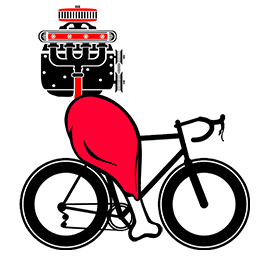Eccentric Resistance Training on the Bike. An Alternative to Pushing Big Gears for Added Strength
A 2014 study examined whether eccentric cycling training could improve muscle size and maximum cycling power in 23 recreational athletes. Eccentric cycling involves pedaling while resisting the forward motion of the cranks to generate high forces. The study found just two sessions per week of eccentric cycling for eight weeks led to significant improvements.
What is eccentric cycling?
An easy way to understand eccentric training is to think of the bench press. When you push the bar up, that is concentric training, when you prevent a heavy bar from crashing back down into your chest, that is eccentric muscle development. To do this on a bike would mean to push against the pedals as they attempt to spin backwards against you. In the video below, the backwards force is being resisted by the cyclist. He IS attempting to pedal forward but the motor turning the pedals backward on the bike is more powerful, causing him to appear to pedaling backwards, even though he is attempting to forward pedal.
Participants did 5-10 minutes of eccentric cycling at 20-55% of their maximum power, 2 times per week for eight weeks (a total of 75 minutes of training). The researchers measured participants’ quadriceps muscle thickness and pennation angles before, one week after, and eight weeks after the training. Quadriceps are the large muscles in the front of the thigh that power cycling. Muscle thickness indicates muscle size. Pennation angles refer to the orientation of muscle fibers and are a measure of how much force a muscle can produce.
One week after training ended, participants’ rectus femoris, one of the quad muscles, was 24% thicker. Their vastus lateralis, another quad muscle, was 13% thicker. Both muscles also had greater pennation angles, indicating they were better positioned to generate force.
Maximum cycling power increased 5% at one week post-training and 9% at eight weeks post-training. The larger gain at 8 weeks suggests participants’ muscles and nervous systems took time to fully recover from the demanding eccentric exercise before showing performance improvements.
Eccentric cycling provides a potent stimulus to induce muscle growth and strength changes with very small time commitments. However, the initial suppressive effects appear to delay maximum power benefits for some weeks. Endurance athletes seeking to improve muscle size and cycling performance may benefit from trying a short-term eccentric cycling program in their training. Two sessions a week of 5-10 minutes at moderate intensities for eight weeks could yield substantial rewards when followed by adequate recovery. The minimal volume required also makes eccentric cycling an option when time is limited.
In conclusion, this small study shows eccentric cycling’s potential as an efficient tool for endurance athletes to build muscle and boost their power and pedaling effectiveness. However, the ideal way to determine how eccentric cycling can enhance endurance performance for a given athlete is through experimentation. Trying a short-term program, assessing the individual response, and giving adaptations adequate time to manifest can help clarify if and how eccentric cycling should be incorporated into an athlete’s long-term training.
Abstract
Chronic eccentric cycling improves quadriceps muscle structure and maximum cycling power
An interesting finding from eccentric exercise training interventions is the presence of muscle hypertrophy without changes in maximum concentric strength and/or power. The lack of improvements in concentric strength and/or power could be due to long lasting suppressive effects on muscle force production following eccentric training. Thus, improvements in concentric strength and/or power might not be detected until muscle tissue has recovered (e. g., several weeks post-training). We evaluated alterations in muscular structure (rectus-femoris, RF, and vastus lateralis, VL, thickness and pennation angles) and maximum concentric cycling power (Pmax) 1-week following 8-weeks of eccentric cycling training (2×/week; 5-10.5 min; 20-55% of Pmax). Pmax was assessed again at 8-weeks post-training. At 1 week post-training, RF and VL thickness increased by 24±4% and 13±2%, respectively, and RF and VL pennation angles increased by 31±4% and 13±1%, respectively (all P<0.05). Compared to pre-training values, Pmax increased by 5±1% and 9±2% at 1 and 8 weeks post-training, respectively (both P<0.05). These results demonstrate that short-duration high-intensity eccentric cycling can be a time-effective intervention for improving muscular structure and function in the lower body of healthy individuals. The larger Pmax increase detected at 8-weeks post-training implies that sufficient recovery might be necessary to fully detect changes in muscular power after eccentric cycling training.
International Journal of Sports Medicine 2014 Jun;35(7):559-65. doi: 10.1055/s-0033-1358471. Epub 2013 Nov 14.
https://doi.org/10.1055/s-0033-1358471
C. H. Leong, W. J. McDermott, S. J. Elmer, J. C. Martin
Listen to the Two Minute Study Summary

Jordan Fowler has experience as a head swimming coach of the Frisco Swim Team, a TAAF-awarded coach, a track and field distance running consultant for select Texas High School runners, and has competed as a triathlete, road runner, and cyclist. Though he is remarkably slower than he was in his 20s and 30s, he still enjoys endurance sports and sports science studies.
